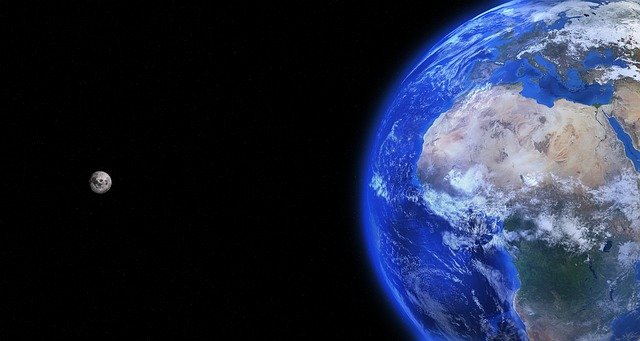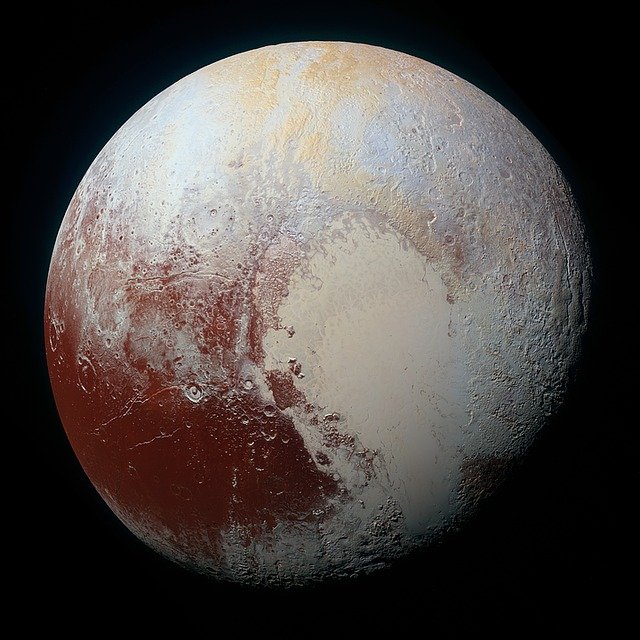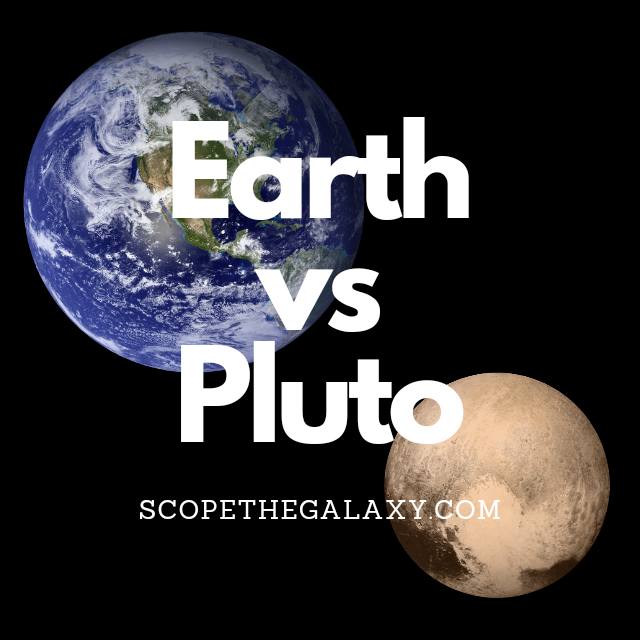*This post may contain affiliate links. This means we may make a commission if you purchase an item using one of our links*
The main differences between Earth and Pluto is that Earth is roughly 5 times bigger, has only 1 moon in comparison to Pluto’s 5, is an officially recognized planet as opposed to Pluto that is a dwarf planet, is able to sustain life and is the 3rd farthest planet from the Sun whilst Pluto is 9th.
There are a variety of other differences between the two so continue reading if you want a more thorough look and breakdown as to what these differences are as well as some of the similarities they share.
What Is The Planet Earth?
Table of Contents

Our home planet Earth is the 3rd farthest planet from the Sun, made up of a mixture of water and solid rock like objects, and is the only entity in our solar system known to allow intelligent life forms like ourselves to exist.
Earth’s distance of 152 million km from the Sun has allowed it to remain within the goldilocks zone and as a result, the planet has been able to thrive for millions of years. It orbits the Sun in a circular pattern, much like all the other planets, has only one natural satellite which would be the Moon and is a terrestrial planet to boot.
In regards to its diameter, Earth is the 5th largest planet with a diameter 12,742km.
Earth’s temperature ranges based on the region you’re located where it can be from as low as -94 degrees Celsius in Antarctica to as high as 50 – 55 degrees Celsius in Tunisia.
As for the planets composition, it consists of the crust, the mantle, the outer core and the inner core, where the inner core is the hottest element within the Earth reaching temperature in excess of 5,200 degrees Celsius.
In regards to some of its most unique features, Earth is around 71% water, has an atmosphere consisting mostly of oxygen and nitrogen that is also made up of 5 main layers, with the highest to lowest being the troposphere, stratosphere, mesosphere, thermosphere and exosphere.
A day on Earth is 24 hours and an orbital cycle around the Sun takes 365 days to complete. It’s axial tilt is more distinct at 23.5 degrees to the right.
What Is The Planet Pluto?

In the past Pluto was the 9th farthest official planet in our solar system however, in 2006 after many debates between astronomers, the International Astronomical Union officially downgraded it to a dwarf planet.
The reason for this downgrade at the time was primarily down to Pluto simply being very small when compared to every other planet and even the moons orbiting these planets. Pluto’s dwarf status is debated still to this day but, for now it still remains under this dwarf bracket for a planet
Its diameter for example is only 2,370km, which is a third of Earth’s Moon. With that being said, despite the significant size discrepancy Pluto shows, it still does have more moon like objects orbiting it than Earth and I’m not saying just one more.
In total this terrestrial dwarf planet has 5.
Pluto’s atmosphere consists mostly of molecular nitrogen whilst molecules of methane and carbon monoxide have been observed also. As for its surface, it consist mostly of frozen nitrogen, methane, and carbon monoxide ices.
One of Pluto’s most unique characteristic is that Charon (its largest moon) is tidally locked to it and vice versa, which means that the two essentially orbit each other.
In essence only one side of Charon and one side of Pluto surface will face each other at any given time.
Pluto’s temperature is between -222 to -232 degrees Celsius based on how close it gets to the Sun when orbiting it, whilst its core temperature isn’t anything too special sitting around 500 – 1,000 degrees Celsius.
The main reason it’s as cold as it is and has a relatively cold core in comparison to the other planets would be, which is mostly down to its size. A larger size would mean more mass could be compressed at the center which would produce more heat at the core.
Pluto’s orbit is also different from the other main plants in our solar system, following an elliptical orbital path as opposed to the circular path the others take. As a result of its distance from the Sun, Pluto will complete each one of these elliptical cycles around once every 247.78 years.
Even its rotational cycle is very slow, where one cycle is completed in 157 hours. Another interesting fact is the Pluto’s axial tilt is almost on its side at 57 degrees, similar to Uranus.
Similarities Between Earth And Pluto
Earth and Pluto do have a few similar features, which would include the below:
- Both have a hotter central core.
- Both have natural satellites orbiting them.
- Both are terrestrial planets.
- Both have an atmosphere and a rocky surface.
- Both are spherical in shape.
- Neither are tidally locked to the Sun.
- Both have no rings surrounding them.
Differences Between Earth And Pluto
In regards to the differences between Earth and Pluto, they would include the following:
- Earth is the bigger of the two where Earth’s diameter is 12,742km whilst Pluto is 2,370km.
- Pluto has 5 moon whilst Earth only has 1.
- Earth is 71% water and 29% land whilst Pluto is mostly land with its surface consisting of frozen nitrogen, methane, and carbon monoxide ices.
- A day on Earth is 24 hours whilst a Pluto day is 157 hours.
- Pluto orbits the Sun in an elliptical pattern whilst Earth does so in a circular pattern.
- Earth is the warmer of the two where it has an average temperature of 13.9 degrees Celsius whereas Pluto’s average is -222 to -232 degrees Celsius.
- Earth’s axial tilt is 23.5 degrees whereas Pluto’s is 57 degrees.
- Pluto is tidally locked to its moon Charon whilst Earth isn’t tidally locked to the moon.
- Earth’s gravity is far stronger than Pluto’s where it is 9.807 m/s² compared to Pluto’s 0.62 m/s².
- Pluto has lower density at 1.88 g/cm³ compared to Earth’s 5.51 g/cm³.
- A year on Earth takes 365 days whilst Pluto completes its orbit around the Sun in 247.78 years.
- Pluto’s atmosphere is significantly thinner than Earth’s where it is roughly 1/100,000 the pressure of Earth’s.
Summary
Although Earth and Pluto are part of the same solar system and share a similar overall composition due to their terrestrial nature, they differ significantly in how they function and how effective they are in harboring life.
Whether it be their differences in size, gravity, density, the length of their days and beyond, and their official status where one is a dwarf planet and the other a normal planet. It’s clear to see that Earth and Pluto are genuinely very distinct entities and operate very different from one another.

